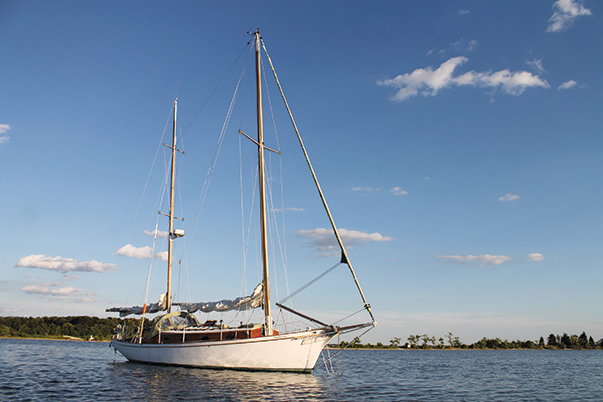Circumnavigators savor the pleasures of birding on the Chesapeake Bay (published April 2013)
Our first visit to the Chesapeake Bay had been cold and rushed. My husband Seth and I were still completing the refit of our 38-foot cutter-rigged sloop Heretic for our global circumnavigation, and Jack Frost had been hard on our heels since leaving our homeport of Maine in October. Trying to keep just ahead of winter, Heretic nosed into The Chesapeake from the C & D Canal after battling headwinds and choppy seas up the Delaware Bay. Suddenly the wind was light and fair, the water calm and tinted pink with a November sunset. A few gentle hills rose to starboard, the trees yellow and dropping their leaves.
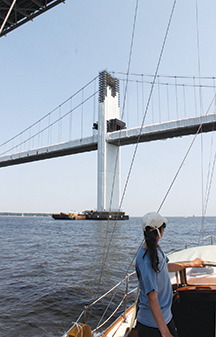
We reached Rock Hall, on Maryland’s Eastern Shore at midnight and the next morning woke to boat projects. Seth kept too busy changing fuel filters to notice the Canada geese arriving on their migration south. Since I was cooped up in the paint shed of our marina and boatyard, the Sailing Emporium, I didn’t see them either. The summer residents—ospreys, field sparrows and orioles—had already flown, and some of the winter migrants, such as the canvasback duck had yet to arrive.
Since it was November, Rock Hall felt sleepy, but nonetheless, it provided us with groceries, last minute stores from West Marine, and even a night out at the Brahma Bull pub. When we departed on a crisp following breeze, we sailed straight down the Chesapeake nonstop and passed by most of it in the coal black of a moonless night. All we saw were the lights of navigation markers and ships in the channel.
BACK IN THE BAY
Seth and I returned to the Chesapeake in June 2012, determined to see a little more of it. We had sold Heretic upon completion of our circumnavigation, thinking that work would leave us little time for sailing in the near future. But once a sailor always a sailor, and we quickly found a way to make time. We had come to Maryland to purchase a 34 foot modified Herreshoff ketch. Nahma was moored in Cambridge on the Eastern Shore, so it was there that our cruise began.
Cambridge, a little ways up the Choptank River from the main bay of the Chesapeake, is much larger than Rock Hall, containing a boulevard lined with mega stores like WalMart. R&D Boat Supply and Ace Hardware were a little beyond walking distance, but the bricked street in the leafy town center boasted a sail loft and a gourmet pub serving grits with fresh shrimp and locally-brewed porter. My favorite moments in Cambridge, however, were watching the barn swallows that fluttered about the piers and the great blue heron that made Nahma’s dock his nightly fishing grounds. If we stayed very quiet, he ignored us and we could watch him stretch his beak towards the water.
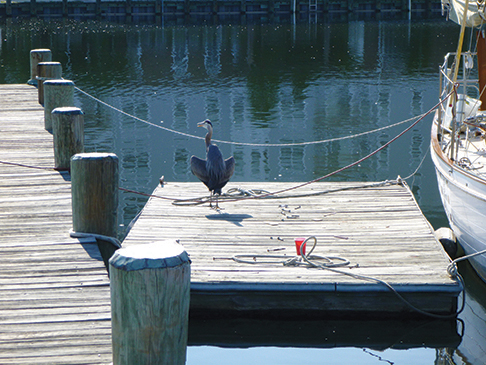
BIRDS OF A FEATHER
We were discovering the rich and varied bird life of the Chesapeake, something we had altogether missed on our last visit. Nowhere was it more concentrated than on our next stop, La Trappe Creek, only five miles down the Choptank from Cambridge. A tranquil, protected anchorage was a fine reward after the two hours we spent beating to windward to reach it. Sunset bathed the cove in reddish hues, silhouetting the wetland forest. Wind rustled the cordgrass and a few warblers trilled.
The next day, Seth and I rowed our dinghy up the creek, twisting further into the marshland and its tall shrubs. We ran softly aground in the mud at its head and let the currents swing us as we watched the sky and trees for birds. We kept as quiet as possible, hoping not to disturb the wildlife. A flock of red-winged blackbirds chattered at us; a common grackle, black with yellow eyes, sat calmly on a branch and a great blue heron fled his perch with loud, pumping wings. Ospreys glided overhead, intent on a meal. Just on the edge of the cordgrass, a green heron, shy and silent, stalked minnows on yellow legs and long splayed feet. Green herons are one of the few tool-using animals—they sometimes drop insects on the water as bait for fish. As we started to row home to Nahma, we glimpsed a cardinal, flaming red against the blue sky.
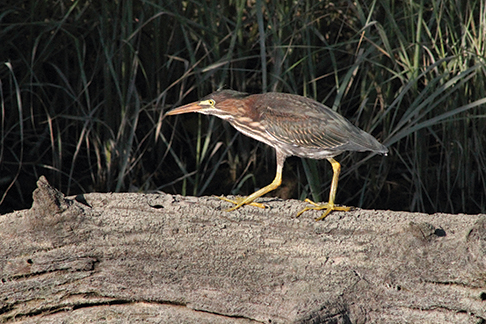
We left behind the beautiful little green heron when we sailed north the next day, but the ospreys followed us. A long day’s windward beat brought us to the Rhode River, this time on the Western Shore. Nests cluttered every navigation marker, filled with baby ospreys awaiting the evening’s fish. The Western Shore was much busier than the eastern, especially after La Trappe Creek where Nahma had been one of four anchored yachts—on weekends, however, the little cove sometimes holds as many as 20 boats. Rhode River, a northern arm of West River south of Annapolis, hosted a number of yachts, but we had plenty of room to anchor.
GUNKHOLING NORTH
We had already visited Annapolis by car with friends from the area and found it a quaint brick town busy with people. The line for the renowned Middleton Tavern, founded in 1750, spilled out the door, but our friends managed to secure a table upstairs in the bar where we dined on Chesapeake crab cakes. The visit had satisfied our need for city bustle, so Seth and I decided to skip it as we gunk-holed north. The anchoring restrictions and the difficulty and expense ($30 a day) of procuring a mooring there—they are available on a first-come, first-served basis and are often full—also incited us to keep to rural areas to search out more birds instead.
The wind shifted west in the morning, so for the first time we set sail on a beam reach rather than close-hauled. We passed the Thomas Point Shoal lighthouse, a white structure on stilts above the rocks, and crossed a line of training vessels from the U.S. Naval Academy. We slid under the immense double bridge to Annapolis, and behind it’s heat wall, our kind breeze died. We resigned ourselves to motor-sailing the rest of the way to Rock Hall.
Originally called Rock Hall Crossroads because of its location right on the main bay rather than up an inlet where so many Chesapeake settlements are situated, it was too convenient a location to miss. Seth and I weren’t outfitting our boat this time, so we anchored in Swan Creek rather than stay in a marina. We watched our depth sounder carefully as we inched our way in, since the creek, like most of the Chesapeake, is extremely shallow. Visiting in summer this time, we found Rock Hall greener and busier than before. The Brahma Bull pub had closed but Durding’s Store, the retro ice cream parlor, was open across the street, so we ordered milkshakes to stave off the humid heat. Back aboard Nahma we watched mallards paddle by and yet another great blue heron fish from a rock.
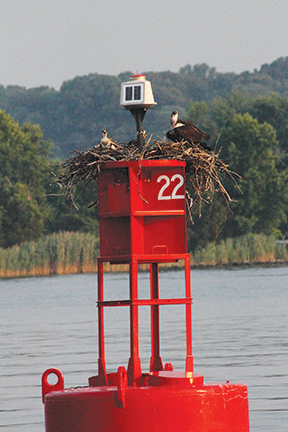
Our final stop was Piney Creek Cove at the mouth of the C & D Canal, where we waited for the tide to take us through to the Delaware Bay. Once through, we planned to make a fast passage to Maine, stopping only at Block Island to take in the Fourth of July festivities, so this would be our last Chesapeake anchorage. It seemed strange to see the hills I had noticed a few years before so verdant with summer. The then deserted navigation markers were now alive with ospreys, perfect platforms for their nests.
We watched the adults bring dinner to their young, and I remembered all the birds we had seen on our four-year voyage aboard Heretic: blue-footed boobies in the Galapagos, Royal albatrosses off New Zealand, sulfur-crested cockatoos in Australia and flocks of gannets off the Cape of Good Hope. Because of our boat work, I had missed the winter migrants when we had passed through the Chesapeake then; and because of the time of year, I had missed all the ospreys, blackbirds and herons. Now I felt that we had righted a missing portion of our voyage: our East Coast backyard.
Ellen Massey Leonard recently completed a four-year 32,000 nautical mile circumnavigation of the globe with her husband Seth aboard Heretic, their 38-foot semi-custom cutter, built 1968. Their westward voyage took them from Blue Hill, Maine south to the Panama Canal and across the Pacific to New Zealand and Australia. They crossed the South Indian Ocean to round the Cape of Good Hope and sailed northwest the length of the Atlantic to the Caribbean and back to Maine. Following the voyage, they sold Heretic and moved to Switzerland for Seth’s work, but after a year without a boat, they found a way to make time for sailing. They now split their time between Switzerland and their 34-foot modified L. Francis Herreshoff ketch Nahma, which is home-ported in Deer Isle, Maine. Ellen is currently at work on a book about their circumnavigation.
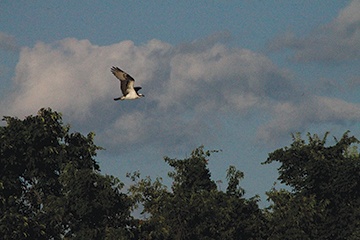
Spring and Fall Migrations
The Chesapeake Bay lies on the eastern flyway for migratory birds and is home to several species that winter over while their Arctic homes are buried in snow and ice. For cruisers, the best sailing seasons are also the best for birding. Get up early, carry your binoculars and bird book and meet our winged cousins who are the original snow birds.
The spring migration brings to the bay more than 200 varieties of birds, some of which have flown all the way from South America. You’ll find more than 30 species of warblers filling the morning with song. You’ll see vireos, flycatchers, kinglets, waterthrush and even great horned owls, if you get up early enough. Plus the marshes, river mouths and bays will be covered with all varieties of duck, geese, swan, gulls, terns and osprey.
The fall migration brings to the bay hundreds of northern species that stop over to feed and rest before setting off for South and Central America and the Caribbean. Many will stay for the winter, including ducks, geese, grebes and swans. Others will carry on south. The great Blue Heron, for example, will depart the bay in October and fly offshore all the way to South America with stops in the islands along the way.
In fall, if you are lucky, you can see the big raptors winging south including all manner of hawks, falcons and even bald eagles. Their traditional route lies slightly to the west, but many use the bay as a way station on their routes south and some, like the osprey, make the bay their summer quarters.















